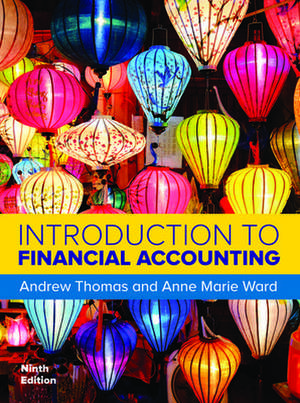Introduction to Financial Accounting, 9e
Autor Andrew Thomas, Anne Marie Warden Limba Engleză Paperback – 21 feb 2019
For students undertaking a degree in accounting or business studies, this ninth edition has been fully revised and updated to the latest accounting standards. It provides a contemporary approach whilst retaining its highly valued concise, student-friendly chapters and practical content. This essential resource is packed with real world examples, worked examples and exercises to keep students engaged and to aid understanding of complex accounting theory.
Supported by McGraw-Hill Education’s market-leading digital adaptive technology including:
- Connect, a highly reliable, easy-to-use homework and learning management solution that embeds learning science and award-winning adaptive tools to improve student results.
- SmartBook®, our adaptive reading, study and practice environment specific to the book’s content.
For students: Connect features assignments that help you contextualize what you’ve learned through application, helping you synthesize information and think critically. SmartBook® helps you study more efficiently by highlighting where in the chapter to focus, asking review questions, and pointing you to resources until you understand.
For instructors: Create auto-graded assignments, tests and quizzes online that can be easily tailored to the goals of your course and your students’ needs. Connect will automatically grade assignments and quizzes, providing you with easy-to-read reports, so you know which students need more guidance. Instructor resources also include PowerPoints, instructors’ manual and solutions manual.
NEW TO CONNECT for 2022:
In response to customer needs, 100 brand new calculation based Problems have been added to Connect to further develop students practical application skills and cement theoretical understanding.
Preț: 449.01 lei
Preț vechi: 488.05 lei
-8% Nou
Puncte Express: 674
Preț estimativ în valută:
85.92€ • 89.95$ • 71.09£
85.92€ • 89.95$ • 71.09£
Carte disponibilă
Livrare economică 15-29 martie
Livrare express 04-08 martie pentru 67.18 lei
Preluare comenzi: 021 569.72.76
Specificații
ISBN-13: 9781526803009
ISBN-10: 1526803003
Dimensiuni: 194 x 262 x 31 mm
Greutate: 1.48 kg
Ediția:9
Editura: McGraw Hill Education
Colecția McGraw Hill / Europe, Middle East & Africa
Locul publicării:United Kingdom
ISBN-10: 1526803003
Dimensiuni: 194 x 262 x 31 mm
Greutate: 1.48 kg
Ediția:9
Editura: McGraw Hill Education
Colecția McGraw Hill / Europe, Middle East & Africa
Locul publicării:United Kingdom
Cuprins
PART 1: Theframework of accounting
1 Entities and financial reporting statements (including the natureand objectives of financial accounting)
2 Financial reporting: institutional framework and standards
3 The Conceptual Framework 1: objective of financial statements,stakeholders and other reports
4 The Conceptual Framework 2: concepts, principles and policies
5 The Conceptual Framework 3: the qualitative characteristics offinancial information
6 Auditing, corporate governance and ethics
PART 2: Double-entry bookkeeping (recording transactions and thebooks of account)
7 The accounting equation and its components
8 Basic documentation and books of account
9Double entry and the general ledger
10 The balancing of accounts and the trial balance
11 Day books and the journal
12 The cash book and petty cash book
PART 3: Preparing final financial statements for sole traders
13 The final financial statements of sole traders (introductory)
14 Adjustment for depreciation and non-current assets
15 Irrecoverable receivables and allowance for irrecoverablereceivables
16 Adjustment for accruals and prepayments
17 Inventory valuation
18 The extended trial balance and final financial statements(advanced)
PART 4: Internal control and check
19 The bank reconciliation statement
20 Control accounts
21 Errors and suspense accounts
22 Single entry and incomplete records
PART 5: Partnerships
23 The final financial statements of partnerships
24 Changes in partnerships
25 Partnership dissolution and conversion to a limited company
PART 6: Companies
26 The nature of limited companies and their capital
27 The final financial statements of limited companies
28 Statement of cash flows
29 The appraisal of company financial statements using ratio analysis
Appendix 1: Case studies
Appendix 2: Solutions to exercises
Glossary
Index
1 Entities and financial reporting statements (including the natureand objectives of financial accounting)
2 Financial reporting: institutional framework and standards
3 The Conceptual Framework 1: objective of financial statements,stakeholders and other reports
4 The Conceptual Framework 2: concepts, principles and policies
5 The Conceptual Framework 3: the qualitative characteristics offinancial information
6 Auditing, corporate governance and ethics
PART 2: Double-entry bookkeeping (recording transactions and thebooks of account)
7 The accounting equation and its components
8 Basic documentation and books of account
9Double entry and the general ledger
10 The balancing of accounts and the trial balance
11 Day books and the journal
12 The cash book and petty cash book
PART 3: Preparing final financial statements for sole traders
13 The final financial statements of sole traders (introductory)
14 Adjustment for depreciation and non-current assets
15 Irrecoverable receivables and allowance for irrecoverablereceivables
16 Adjustment for accruals and prepayments
17 Inventory valuation
18 The extended trial balance and final financial statements(advanced)
PART 4: Internal control and check
19 The bank reconciliation statement
20 Control accounts
21 Errors and suspense accounts
22 Single entry and incomplete records
PART 5: Partnerships
23 The final financial statements of partnerships
24 Changes in partnerships
25 Partnership dissolution and conversion to a limited company
PART 6: Companies
26 The nature of limited companies and their capital
27 The final financial statements of limited companies
28 Statement of cash flows
29 The appraisal of company financial statements using ratio analysis
Appendix 1: Case studies
Appendix 2: Solutions to exercises
Glossary
Index
